1, Abnormal
1. Anomaly concept & anomaly system
Anomaly concept
Abnormal means abnormal. In life: the doctor said that there is an abnormality in a part of your body, which is a little different from normal, and the function of this part will be affected In the program, it means:
- Exception: refers to an abnormal situation during the execution of the program, which will eventually lead to the abnormal stop of the JVM.
In object-oriented programming languages such as Java, the exception itself is a class. Generating an exception is to create an exception object and throw an exception object. The way Java handles exceptions is interrupt handling.
An exception does not refer to a syntax error. If the syntax is wrong and the compilation fails, a bytecode file will not be generated and cannot run at all.
Abnormal system
The exception mechanism actually helps us find problems in the program.
The root class of the exception is Java lang.Throwable
There are two subclasses under it: Java Lang. error and Java lang.Exception ,
The usual exception refers to Java lang.Exception
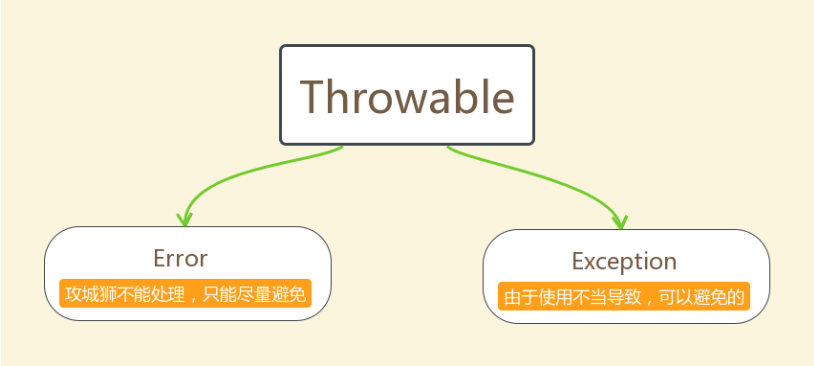
Throwable system:
Error: a serious error. An error that cannot be handled can only be avoided in advance, like a terminal disease.
Exception: indicates an exception. After an exception is generated, the programmer can correct it through code to make the program continue to run. It must be handled. Like cold, appendicitis.
2. Anomaly classification
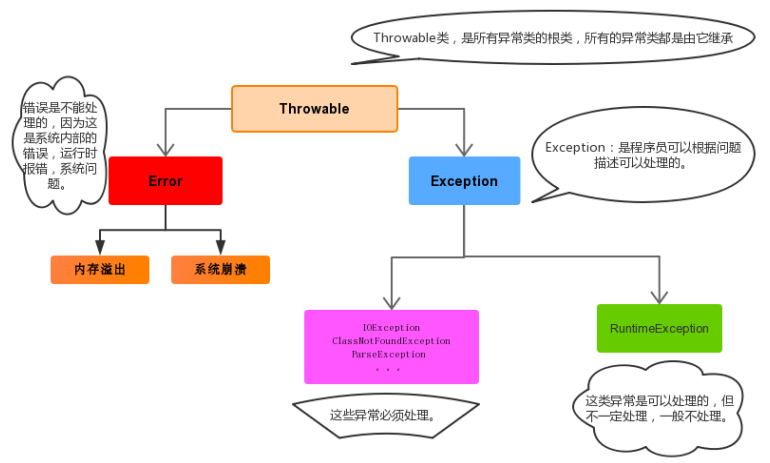
package com.itheima.demo01.Exception;
/*
java.lang.Throwable:Class is a superclass for all errors or exceptions in the Java language.
Exception:Compile time exceptions, problems in compiling (writing code) java programs
RuntimeException:Run time exceptions, problems in the running process of java programs
The exception is equivalent to a small problem (cold, fever) in the program. Deal with the exception and the program can continue to execute (take some medicine and continue the revolutionary work)
Error:error
A mistake is equivalent to an incurable disease in the program (SARS, AIDS) The source code must be modified before the program can continue
*/
public class Demo01Exception {
public static void main(String[] args) /*throws ParseException*/ {
//Exception: compile time exception, which is a problem in compiling (writing code) java programs
/*SimpleDateFormat sdf = new SimpleDateFormat("yyyy-MM-dd");//Used to format the date
Date date = null;
try {
date = sdf.parse("1999-0909");//Parse the Date in string format into Date format
} catch (ParseException e) {
e.printStackTrace();
}
System.out.println(date);*/
//RuntimeException: run-time exception, a problem that occurs during the running of a java program
/*int[] arr = {1,2,3};
//System.out.println(arr[0]);
try {
//Code with possible exceptions
System.out.println(arr[3]);
}catch(Exception e){
//Exception handling logic
System.out.println(e);
}*/
/*
Error:error
OutOfMemoryError: Java heap space
Memory overflow error. The array created is too large and exceeds the memory allocated to the JVM
*/
//int[] arr = new int[1024*1024*1024];
//The code must be modified to create a smaller array
int[] arr = new int[1024*1024];
System.out.println("Subsequent code");
}
}
3. Analysis of abnormal generation process
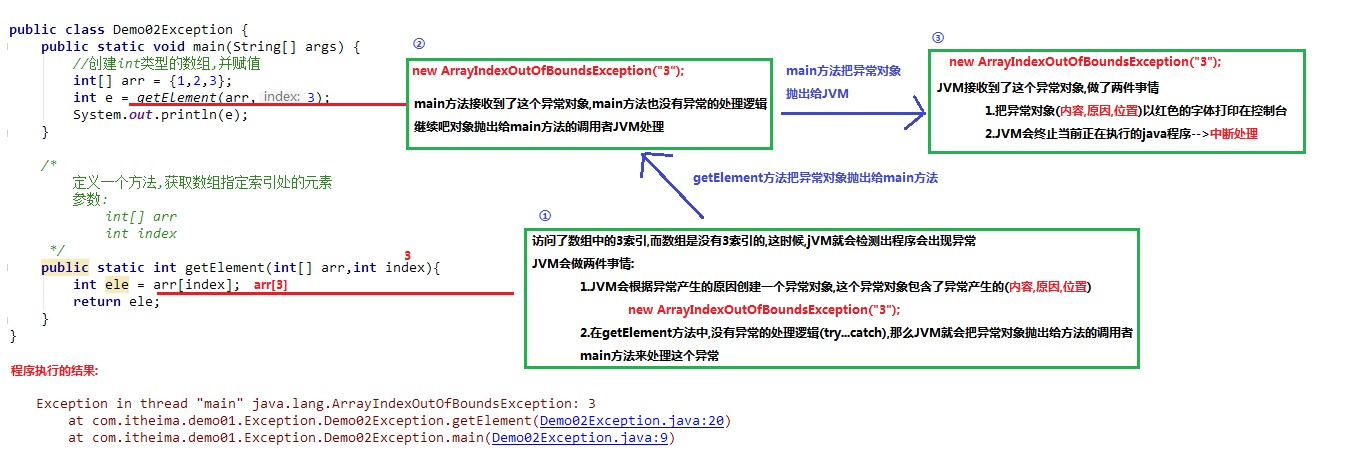
2, Exception handling
1.throw keyword
package com.itheima.demo01.Exception;
/*
throw keyword
effect:
You can use the throw keyword to throw the specified exception in the specified method
Use format:
throw new xxxException("Cause of abnormality ");
be careful:
1.throw Keywords must be written inside the method
2.throw The object of new after the keyword must be an Exception or a subclass object of Exception
3.throw Keyword to throw the specified exception object, we must deal with the exception object
throw After the keyword, RuntimeException or a subclass object of RuntimeException is created. We can not handle it. It is handed over to the JVM for processing by default (print exception object and interrupt program)
throw After the keyword, a compilation exception is created (an error is reported when writing code). We must deal with this exception, either throw or try catch
*/
public class Demo03Throw {
public static void main(String[] args) {
//int[] arr = null;
int[] arr = new int[3];
int e = getElement(arr,3);
System.out.println(e);
}
/*
Defines a method to get the element at the specified index of the array
Parameters:
int[] arr
int index
In the future (work), we must first verify the validity of the parameters passed by the method
If the parameter is illegal, we must throw an exception to inform the caller of the method that there is a problem with the passed parameter
be careful:
NullPointerException It is a runtime exception. We don't need to handle it. It is handed over to the JVM by default
ArrayIndexOutOfBoundsException It is a runtime exception. We don't need to handle it. It is handed over to the JVM by default
*/
public static int getElement(int[] arr,int index){
/*
We can verify the validity of the passed parameter array
If the value of array arr is null
Then we throw a null pointer exception and tell the caller of the method that "the value of the passed array is null"
*/
if(arr == null){
throw new NullPointerException("The value of the array passed is null");
}
/*
We can verify the validity of the passed parameter index
If the index range is not within the index range of the array
Then we throw an array index out of bounds exception and tell the caller of the method that "the passed index exceeds the range of use of the array"
*/
if(index<0 || index>arr.length-1){
throw new ArrayIndexOutOfBoundsException("The index passed is out of range for the array");
}
int ele = arr[index];
return ele;
}
}
2.Objects non null judgment requireNonNull method
package com.itheima.demo01.Exception;
import java.util.Objects;
/*
Obects Static methods in classes
public static <T> T requireNonNull(T obj):View that the specified reference object is not null.
Source code:
public static <T> T requireNonNull(T obj) {
if (obj == null)
throw new NullPointerException();
return obj;
}
*/
public class Demo04Objects {
public static void main(String[] args) {
method(null);
}
public static void method(Object obj){
//Judge the validity of the passed parameters to determine whether they are null
/*if(obj == null){
throw new NullPointerException("The value of the object passed is null ');
}*/
//Objects.requireNonNull(obj);
Objects.requireNonNull(obj,"The value of the object passed is null");
}
}
3. Declare exception throws
throws keyword the first way to handle exceptions: leave it to others
package com.itheima.demo01.Exception;
import java.io.FileNotFoundException;
import java.io.IOException;
/*
throws Keyword: the first method of exception handling, which is handed over to others for handling
effect:
When an exception object is thrown inside a method, we must deal with the exception object
You can use the throws keyword to handle the exception object. The exception object declaration will be thrown to the caller of the method for processing (you will not handle it yourself, but others), and finally handed over to the JVM for processing -- > interrupt processing
Use format: used in method declaration
Modifier return value type method name (parameter list) throws aaaexcepton, bbbexcepton {
throw new AAAExcepiton("Cause ");
throw new BBBExcepiton("Cause ");
...
}
be careful:
1.throws Keywords must be written at the method declaration
2.throws The Exception declared after the keyword must be an Exception or a subclass of Exception
3.If multiple exception objects are thrown inside the method, multiple exceptions must also be declared after throws
If multiple exception objects thrown have a child parent relationship, you can directly declare the parent exception
4.If we call a method that declares that an exception is thrown, we must handle the declared exception
Or continue to use the throws declaration to throw it, give it to the caller of the method for processing, and finally give it to the JVM
Or try Catch handles exceptions by itself
*/
public class Demo05Throws {
/*
FileNotFoundException extends IOException extends Excepiton
If multiple exception objects thrown have a child parent relationship, you can directly declare the parent exception
*/
//public static void main(String[] args) throws FileNotFoundException,IOException {
//public static void main(String[] args) throws IOException {
public static void main(String[] args) throws Exception {
readFile("c:\\a.tx");
}
/*
Define a method to judge the legitimacy of the transmitted file path
If the path is not "c:\a.txt", we will throw the file and tell the caller of the method that the exception object cannot be found
be careful:
FileNotFoundException It is a compilation exception. If a compilation exception is thrown, it must be handled
You can use the throws declaration to throw FileNotFoundException, an exception object, for the caller of the method to handle
*/
public static void readFile(String fileName) throws FileNotFoundException,IOException{
if(!fileName.equals("c:\\a.txt")){
throw new FileNotFoundException("The file path passed is not c:\\a.txt");
}
/*
If the path passed is not txt end
Then we throw an IO exception object to tell the caller of the method that the file suffix is wrong
*/
if(!fileName.endsWith(".txt")){
throw new IOException("The suffix of the file is incorrect");
}
System.out.println("There is no problem with the path,read file");
}
}
The second method of trycatch exception handling: handle exceptions yourself
package com.itheima.demo02.Exception;
import java.io.IOException;
/*
try...catch:The second way of exception handling is to handle exceptions by yourself
Format:
try{
Code that may cause exceptions
}catch(Define an exception variable to receive the exception object thrown in the try){
Exception handling logic, how to handle the exception object after the exception object
In general, abnormal information will be recorded in a log during work
}
...
catch(Exception class name (variable name){
}
be careful:
1.try Multiple exception objects may be thrown in, so you can use multiple catch es to handle these exception objects
2.If an exception occurs in try, the exception handling logic in catch will be executed. After executing the handling logic in catch, continue to execute try Code after catch
If there is no exception in the try, the exception handling logic in catch will not be executed. After executing the code in the try, continue to execute the try Code after catch
*/
public class Demo01TryCatch {
public static void main(String[] args) {
try{
//Code that may cause exceptions
readFile("d:\\a.tx");
}catch (IOException e){//catch defines exception variables to receive exception objects thrown in try
//Exception handling logic, how to handle the exception object after the exception object
System.out.println("catch - The file suffix passed is not.txt");
}
System.out.println("Subsequent code");
}
/*
If the path passed is not txt end
Then we throw an IO exception object to tell the caller of the method that the file suffix is wrong
*/
public static void readFile(String fileName) throws IOException {
if(!fileName.endsWith(".txt")){
throw new IOException("The suffix of the file is incorrect");
}
System.out.println("There is no problem with the path,read file");
}
}
The second method of trycatch exception handling: three exception handling methods in the Throwable class
package com.itheima.demo02.Exception;
import java.io.IOException;
/*
try...catch:The second way of exception handling is to handle exceptions by yourself
Format:
try{
Code that may cause exceptions
}catch(Define an exception variable to receive the exception object thrown in the try){
Exception handling logic, how to handle the exception object after the exception object
In general, abnormal information will be recorded in a log during work
}
...
catch(Exception class name (variable name){
}
be careful:
1.try Multiple exception objects may be thrown in, so you can use multiple catch es to handle these exception objects
2.If an exception occurs in try, the exception handling logic in catch will be executed. After executing the handling logic in catch, continue to execute try Code after catch
If there is no exception in the try, the exception handling logic in catch will not be executed. After executing the code in the try, continue to execute the try Code after catch
*/
public class Demo01TryCatch {
public static void main(String[] args) {
try{
//Code that may cause exceptions
readFile("d:\\a.tx");
}catch (IOException e){//catch defines exception variables to receive exception objects thrown in try
//Exception handling logic, how to handle the exception object after the exception object
//System.out.println("catch - the file suffix passed is not. txt");
/*
Throwable Class defines three exception handling methods
String getMessage() Returns a short description of this throwable.
String toString() Returns the detailed message string for this throwable.
void printStackTrace() JVM This method is used by default to print exception objects. The printed exception information is the most comprehensive
*/
//System.out.println(e.getMessage());// The suffix of the file is incorrect
//System.out.println(e.toString());// Override toString Java. Java of Object class io. IOException: the suffix of the file is incorrect
//System.out.println(e);//java.io.IOException: the suffix of the file is incorrect
/*
java.io.IOException: The suffix of the file is incorrect
at com.itheima.demo02.Exception.Demo01TryCatch.readFile(Demo01TryCatch.java:55)
at com.itheima.demo02.Exception.Demo01TryCatch.main(Demo01TryCatch.java:27)
*/
e.printStackTrace();
}
System.out.println("Subsequent code");
}
/*
If the path passed is not txt end
Then we throw an IO exception object to tell the caller of the method that the file suffix is wrong
*/
public static void readFile(String fileName) throws IOException {
if(!fileName.endsWith(".txt")){
throw new IOException("The suffix of the file is incorrect");
}
System.out.println("There is no problem with the path,read file");
}
}
The second method of trycatch exception handling: finally code block
package com.itheima.demo02.Exception;
import java.io.IOException;
/*
finally Code block
Format:
try{
Code that may cause exceptions
}catch(Define an exception variable to receive the exception object thrown in the try){
Exception handling logic, how to handle the exception object after the exception object
In general, abnormal information will be recorded in a log during work
}
...
catch(Exception class name (variable name){
}finally{
It is executed regardless of whether an exception occurs
}
be careful:
1.finally It cannot be used alone. It must be used with try
2.finally It is generally used for resource release (resource recovery). No matter whether the program is abnormal or not, the resource should be released (IO) at last
*/
public class Demo02TryCatchFinally {
public static void main(String[] args) {
try {
//Code that may generate exceptions
readFile("c:\\a.tx");
} catch (IOException e) {
//Exception handling logic
e.printStackTrace();
} finally {
//Whether an exception occurs or not, it is executed
System.out.println("Resource release");
}
}
/*
If the path passed is not txt end
Then we throw an IO exception object to tell the caller of the method that the file suffix is wrong
*/
public static void readFile(String fileName) throws IOException {
if(!fileName.endsWith(".txt")){
throw new IOException("The suffix of the file is incorrect");
}
System.out.println("There is no problem with the path,read file");
}
}
3, Abnormal precautions
1. Exception precautions: capture and handling of multiple exceptions
package com.itheima.demo03.Exception;
import java.util.List;
/*
Abnormal precautions
*/
public class Demo01Exception {
public static void main(String[] args) {
/*
How to deal with multiple exceptions using capture?
1. Multiple exceptions are handled separately.
2. Multiple exceptions are captured once and processed multiple times.
3. Multiple exceptions are captured and processed at a time.
*/
//1. Handle multiple exceptions separately.
/* try {
int[] arr = {1,2,3};
System.out.println(arr[3]);//ArrayIndexOutOfBoundsException: 3
}catch (ArrayIndexOutOfBoundsException e){
System.out.println(e);
}
try{
List<Integer> list = List.of(1, 2, 3);
System.out.println(list.get(3));//IndexOutOfBoundsException: Index 3 out-of-bounds for length 3
}catch (IndexOutOfBoundsException e){
System.out.println(e);
}*/
//2. Multiple exceptions are captured at one time and processed multiple times.
/*try {
int[] arr = {1,2,3};
//System.out.println(arr[3]);//ArrayIndexOutOfBoundsException: 3
List<Integer> list = List.of(1, 2, 3);
System.out.println(list.get(3));//IndexOutOfBoundsException: Index 3 out-of-bounds for length 3
}catch (ArrayIndexOutOfBoundsException e){
System.out.println(e);
}catch (IndexOutOfBoundsException e){
System.out.println(e);
}*/
/*
Precautions for one try multiple catch es:
catch For the exception variable defined inside, if there is a child parent relationship, the exception variable of the child class must be written above, otherwise an error will be reported
ArrayIndexOutOfBoundsException extends IndexOutOfBoundsException
*/
/*try {
int[] arr = {1,2,3};
//System.out.println(arr[3]);//ArrayIndexOutOfBoundsException: 3
List<Integer> list = List.of(1, 2, 3);
System.out.println(list.get(3));//IndexOutOfBoundsException: Index 3 out-of-bounds for length 3
}catch (IndexOutOfBoundsException e){
System.out.println(e);
}catch (ArrayIndexOutOfBoundsException e){
System.out.println(e);
}*/
//3. Multiple exceptions are captured and processed at one time.
/*try {
int[] arr = {1,2,3};
//System.out.println(arr[3]);//ArrayIndexOutOfBoundsException: 3
List<Integer> list = List.of(1, 2, 3);
System.out.println(list.get(3));//IndexOutOfBoundsException: Index 3 out-of-bounds for length 3
}catch (Exception e){
System.out.println(e);
}*/
//The runtime exception is thrown and can not be handled. Neither capture nor declare throw.
//The default is for the virtual machine to process and terminate the program. When will the runtime exception not be thrown and continue to execute the program
int[] arr = {1,2,3};
System.out.println(arr[3]);//ArrayIndexOutOfBoundsException: 3
List<Integer> list = List.of(1, 2, 3);
System.out.println(list.get(3));//IndexOutOfBoundsException: Index 3 out-of-bounds for length 3
System.out.println("Subsequent code!");
}
}
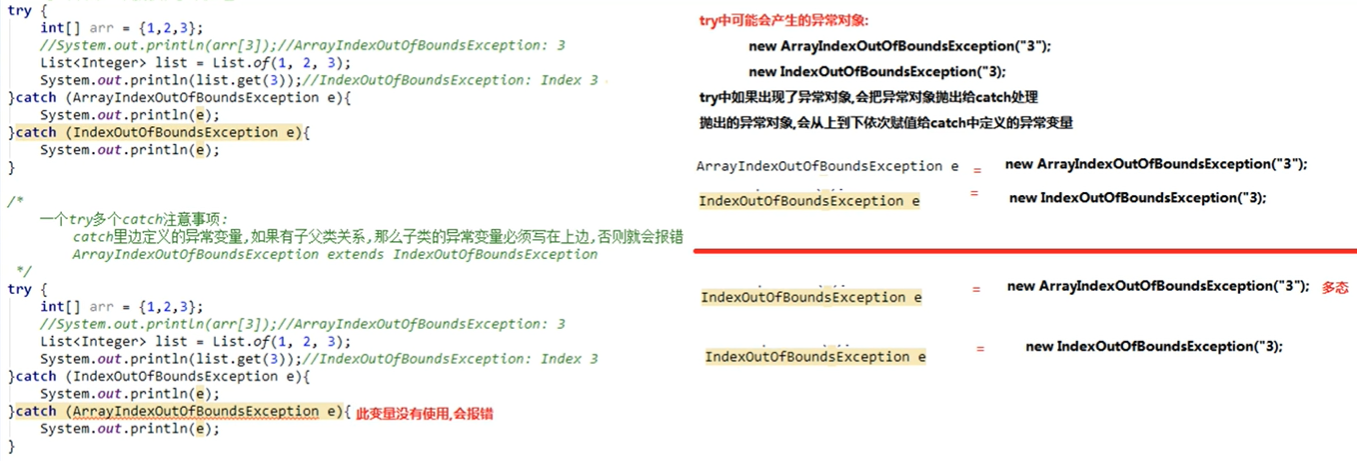
2. Exception precautions finally has a return statement
package com.itheima.demo03.Exception;
/*
If finally has a return statement, always return the result in finally to avoid this situation
*/
public class Demo02Exception {
public static void main(String[] args) {
int a = getA();
System.out.println(a);
}
//Define a method that returns the value of variable a
public static int getA(){
int a = 10;
try{
return a;
}catch (Exception e){
System.out.println(e);
}finally {
//Code that must execute
a = 100;
return a;
}
}
}
3. Exception precautions: child and parent class exceptions
package com.itheima.demo03.Exception;
/*
Exception of child parent class:
- If the parent class throws multiple exceptions, when overriding the parent class method, the child class throws the same exception as the parent class, or the child of the parent class exception, or does not throw an exception.
- The parent class method does not throw an exception, and the child class cannot throw an exception when overriding the parent class method. At this time, the subclass generates the exception, which can only be caught and processed, and cannot be declared and thrown
be careful:
When the parent class is abnormal, the child class is abnormal
*/
public class Fu {
public void show01() throws NullPointerException,ClassCastException{}
public void show02() throws IndexOutOfBoundsException{}
public void show03() throws IndexOutOfBoundsException{}
public void show04() throws Exception {}
}
class Zi extends Fu{
//When a subclass overrides a parent class method, it throws the same exception as the parent class
public void show01() throws NullPointerException,ClassCastException{}
//A subclass that throws a parent exception when overriding a parent method
public void show02() throws ArrayIndexOutOfBoundsException{}
//Subclasses do not throw exceptions when overriding parent methods
public void show03() {}
/*
The parent class method does not throw an exception, and the child class cannot throw an exception when overriding the parent class method.
*/
//public void show04() throws Exception{}
//At this time, the subclass generates the exception, which can only be caught and processed, and cannot be declared and thrown
public void show04() {
try {
throw new Exception("Compile time exception");
} catch (Exception e) {
e.printStackTrace();
}
}
}
4, Custom exception class
1. General
package com.itheima.demo04.MyException;
/*
Custom exception class:
java The provided exception classes are not enough for us to use. We need to define some exception classes ourselves
Format:
public class XXXExcepiton extends Exception | RuntimeException{
Construction method of adding an empty parameter
Add a constructor with exception information
}
be careful:
1.Custom Exception classes generally end with Exception, indicating that this class is an Exception class
2.Custom Exception class, must inherit Exception or RuntimeException
Inherit Exception: then the custom Exception class is a compile time Exception. If a compile time Exception is thrown inside the method, you must handle the Exception, either throw or try catch
Inheriting RuntimeException: the custom exception class is a runtime exception that needs no processing and is handed over to the virtual machine for processing (interrupt processing)
*/
public class RegisterException extends Exception {
//Construction method of adding an empty parameter
public RegisterException(){
super();
}
/*
Add a constructor with exception information
Looking at the source code, it is found that all exception classes will have a constructor with exception information. The constructor with exception information of the parent class will be called inside the method to let the parent class handle the exception information
*/
public RegisterException(String message){
super(message);
}
}
2. Practice of customizing exception classes
package com.itheima.demo04.MyException;
/*
Custom exception class:
java The provided exception classes are not enough for us to use. We need to define some exception classes ourselves
Format:
public class XXXExcepiton extends Exception | RuntimeException{
Construction method of adding an empty parameter
Add a constructor with exception information
}
be careful:
1.Custom Exception classes generally end with Exception, indicating that this class is an Exception class
2.Custom Exception class, must inherit Exception or RuntimeException
Inherit Exception: then the custom Exception class is a compile time Exception. If a compile time Exception is thrown inside the method, you must handle the Exception, either throw or try catch
Inheriting RuntimeException: the custom exception class is a runtime exception that needs no processing and is handed over to the virtual machine for processing (interrupt processing)
*/
public class RegisterException extends Exception {
//Construction method of adding an empty parameter
public RegisterException(){
super();
}
/*
Add a constructor with exception information
Looking at the source code, it is found that all exception classes will have a constructor with exception information. The constructor with exception information of the parent class will be called inside the method to let the parent class handle the exception information
*/
public RegisterException(String message){
super(message);
}
}
package com.itheima.demo04.MyException;
import java.util.Scanner;
/*
Requirements: we simulate the registration operation. If the user name already exists, we throw an exception and prompt: pro, the user name has been registered.
analysis:
1.Use the array to save the registered user name (database)
2.Use Scanner to obtain the registered user name entered by the user (front end, page)
3.Define a method to judge the user name registered in the user input
Traverse the array storing registered user names to obtain each user name
Compare the obtained user name with the user name entered by the user
true:
If the user name already exists, throw a RegisterException exception to tell the user "pro, the user name has been registered";
false:
Continue to traverse the comparison
If the cycle ends and no duplicate user name is found, the user will be prompted with "Congratulations, successful registration!";
*/
public class Demo01RegisterException {
// 1. Use the array to save the registered user name (database)
static String[] usernames = {"Zhang San","Li Si","Wang Wu"};
public static void main(String[] args) /*throws RegisterException*/ {
//2. Use Scanner to obtain the registered user name entered by the user (front end, page)
Scanner sc = new Scanner(System.in);
System.out.println("Please enter the user name you want to register:");
String username = sc.next();
checkUsername(username);
}
//3. Define a method to judge the user name registered in the user input
public static void checkUsername(String username) /*throws RegisterException*/ {
//Traverse the array storing registered user names to obtain each user name
for (String name : usernames) {
//Compare the obtained user name with the user name entered by the user
if(name.equals(username)){
//true: the user name already exists, throw a RegisterException exception, and tell the user "pro, the user name has been registered";
try {
throw new RegisterException("Pro, the user name has been registered");
} catch (RegisterException e) {
e.printStackTrace();
return; //End method
}
}
}
//If the cycle ends and no duplicate user name is found, the user will be prompted with "Congratulations, successful registration!";
System.out.println("Congratulations,login was successful!");
}
}
package com.itheima.demo04.MyException;
/*
Custom exception class:
java The provided exception classes are not enough for us to use. We need to define some exception classes ourselves
Format:
public class XXXExcepiton extends Exception | RuntimeException{
Construction method of adding an empty parameter
Add a constructor with exception information
}
be careful:
1.Custom Exception classes generally end with Exception, indicating that this class is an Exception class
2.Custom Exception class, must inherit Exception or RuntimeException
Inherit Exception: then the custom Exception class is a compile time Exception. If a compile time Exception is thrown inside the method, you must handle the Exception, either throw or try catch
Inheriting RuntimeException: the custom exception class is a runtime exception that needs no processing and is handed over to the virtual machine for processing (interrupt processing)
*/
public class RegisterException extends /*Exception*/ RuntimeException{
//Construction method of adding an empty parameter
public RegisterException(){
super();
}
/*
Add a constructor with exception information
Looking at the source code, it is found that all exception classes will have a constructor with exception information. The constructor with exception information of the parent class will be called inside the method to let the parent class handle the exception information
*/
public RegisterException(String message){
super(message);
}
}
package com.itheima.demo04.MyException;
import java.util.Scanner;
/*
Requirements: we simulate the registration operation. If the user name already exists, we throw an exception and prompt: pro, the user name has been registered.
analysis:
1.Use the array to save the registered user name (database)
2.Use Scanner to obtain the registered user name entered by the user (front end, page)
3.Define a method to judge the user name registered in the user input
Traverse the array storing registered user names to obtain each user name
Compare the obtained user name with the user name entered by the user
true:
If the user name already exists, throw a RegisterException exception to tell the user "pro, the user name has been registered";
false:
Continue to traverse the comparison
If the cycle ends and no duplicate user name is found, the user will be prompted with "Congratulations, successful registration!";
*/
public class Demo02RegisterException {
// 1. Use the array to save the registered user name (database)
static String[] usernames = {"Zhang San","Li Si","Wang Wu"};
public static void main(String[] args) {
//2. Use Scanner to obtain the registered user name entered by the user (front end, page)
Scanner sc = new Scanner(System.in);
System.out.println("Please enter the user name you want to register:");
String username = sc.next();
checkUsername(username);
}
//3. Define a method to judge the user name registered in the user input
public static void checkUsername(String username) {
//Traverse the array storing registered user names to obtain each user name
for (String name : usernames) {
//Compare the obtained user name with the user name entered by the user
if(name.equals(username)){
//true: the user name already exists, throw a RegisterException exception, and tell the user "pro, the user name has been registered";
throw new RegisterException("Pro, the user name has been registered");//Throw run-time exceptions without processing, and hand them over to the JVM for processing and interrupt processing
}
}
//If the cycle ends and no duplicate user name is found, the user will be prompted with "Congratulations, successful registration!";
System.out.println("Congratulations,login was successful!");
}
}
5, Multithreading
1. Concurrency and parallelism
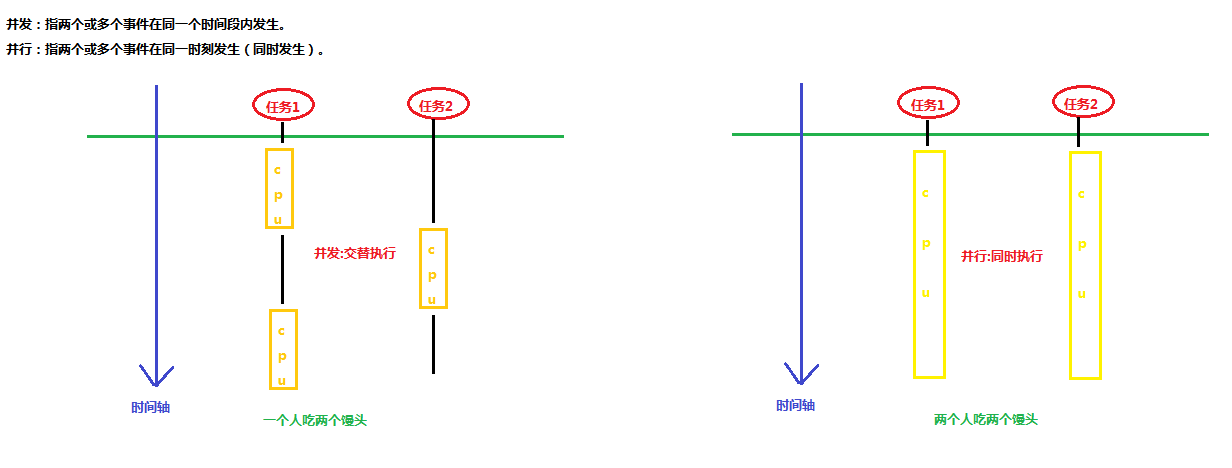
2. Process concept
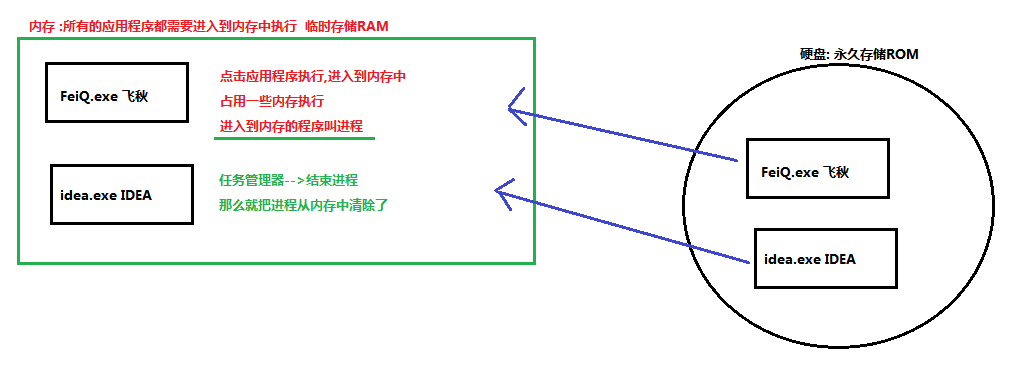
3. Thread concept
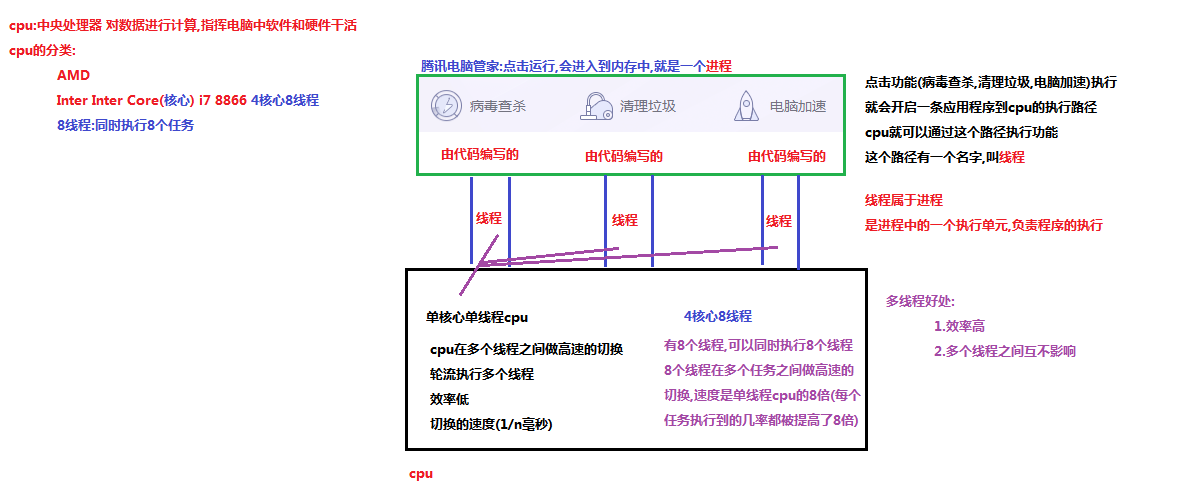
4. Thread scheduling
-
Time sharing scheduling
All threads use the right to use the CPU in turn, and allocate the CPU time of each thread equally.
-
preemptive scheduling
Give priority to the threads with high priority to use CPU. If the threads have the same priority, one will be selected randomly (thread randomness). Java uses preemptive scheduling.
Set thread priority
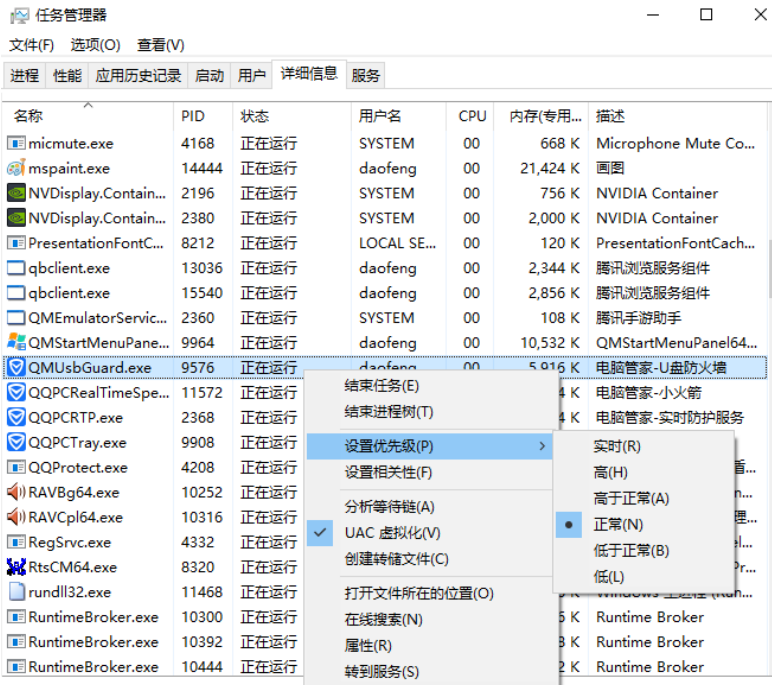
5. Main thread
package com.itheima.demo05.Thread;
public class Person {
private String name;
public void run(){
//Define the cycle and execute it 20 times
for(int i=0; i<20; i++){
System.out.println(name+"-->"+i);
}
}
public Person() {
}
public Person(String name) {
this.name = name;
}
public String getName() {
return name;
}
public void setName(String name) {
this.name = name;
}
}
package com.itheima.demo05.Thread;
/*
Main thread: the thread that executes the main method
Single threaded program: there is only one thread in a java program
The execution starts with the main method and is executed from top to bottom
JVM Execute the main method, and the main method will enter the stack memory
JVM Will find the operating system to open up an execution path from the main method to the cpu
cpu You can execute the main method through this path
This path has a name called the main thread
*/
public class Demo01MainThread {
public static void main(String[] args) {
Person p1 = new Person("cockroach");
p1.run();
System.out.println(0/0);//ArithmeticException: / by zero
Person p2 = new Person("Wangcai");
p2.run();
}
}
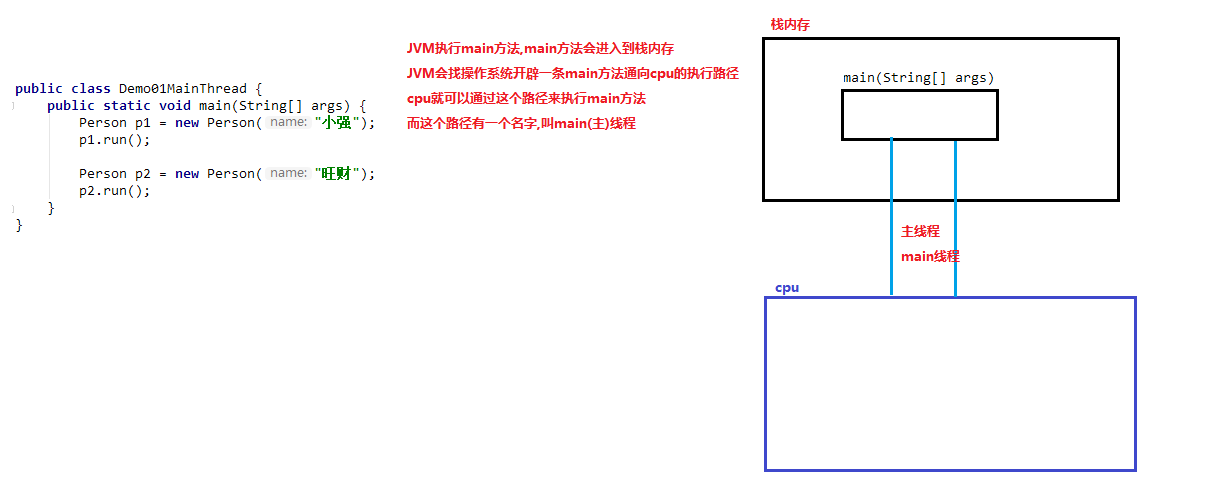
6. The first way to create a multithreaded program: create a subclass of Thread class
package com.itheima.demo06.Thread;
//1. Create a subclass of Thread class
public class MyThread extends Thread{
//2. Override the run method in the Thread class in the subclass of the Thread class and set the Thread task (what do you want to do to start the Thread?)
@Override
public void run() {
for (int i = 0; i <20 ; i++) {
System.out.println("run:"+i);
}
}
}
package com.itheima.demo06.Thread;
/*
The first way to create a multithreaded program: create a subclass of the Thread class
java.lang.Thread Class: a class that describes threads. If we want to implement multithreaded programs, we must inherit the Thread class
Implementation steps:
1.Create a subclass of the Thread class
2.Override the run method in the Thread class in the subclass of the Thread class and set the Thread task (what do you want to do to start the Thread?)
3.Create a subclass object of the Thread class
4.Call the start method in the Thread class to start a new Thread and execute the run method
void start() Start the thread to execute; The Java virtual machine calls the run method of the thread.
The result is that two threads run concurrently; The current thread (the main thread) and another thread (the new thread created executes its run method).
It is illegal to start a thread multiple times. Especially when the thread has finished execution, it cannot be restarted.
java The program belongs to preemptive scheduling. The thread has high priority and the thread has priority to execute; At the same priority, select one execution at random
*/
public class Demo01Thread {
public static void main(String[] args) {
//3. Create subclass objects of Thread class
MyThread mt = new MyThread();
//4. Call the start method in the Thread class to start a new Thread and execute the run method
mt.start();
for (int i = 0; i <20 ; i++) {
System.out.println("main:"+i);
}
}
}